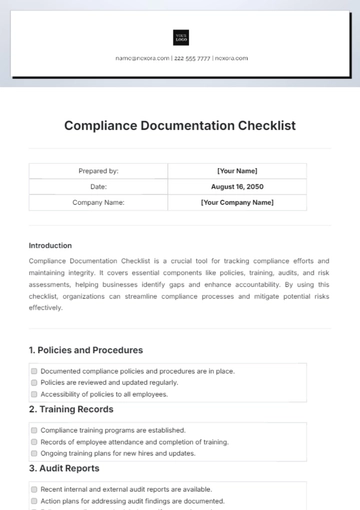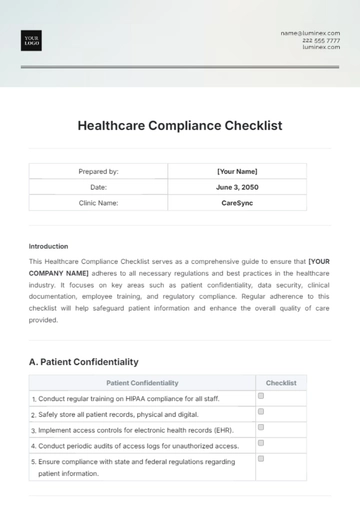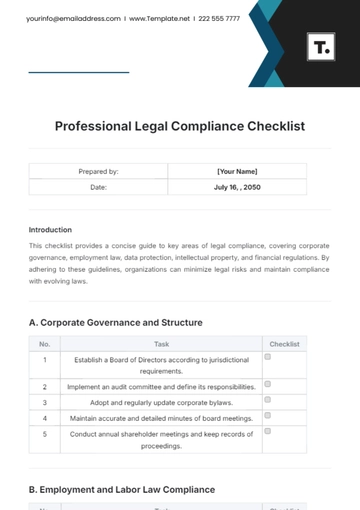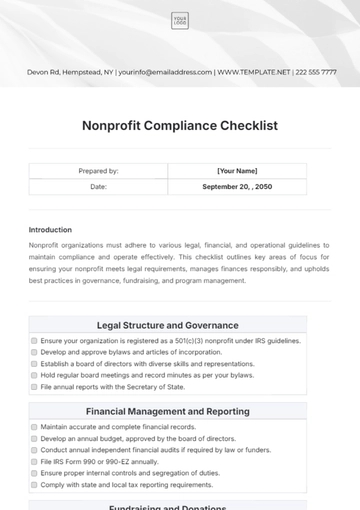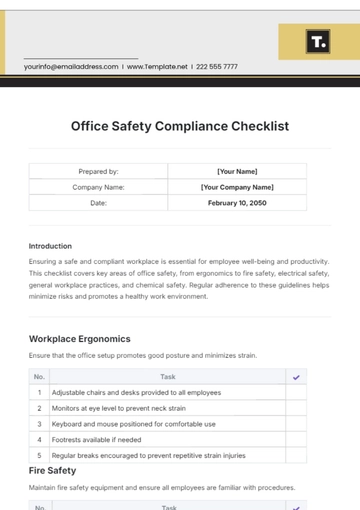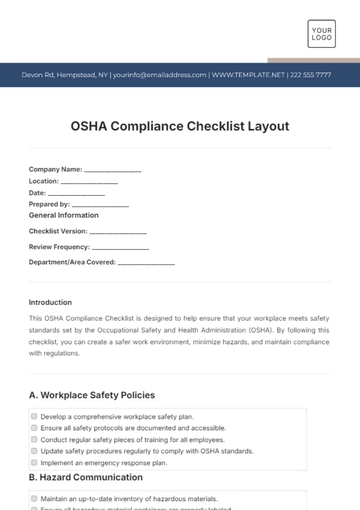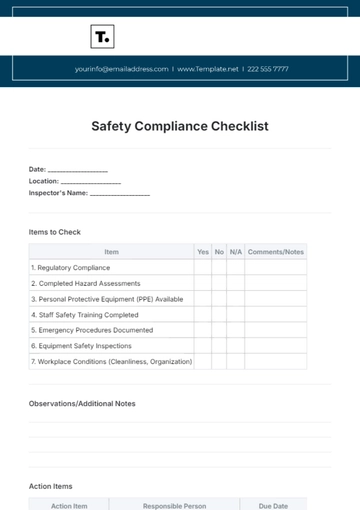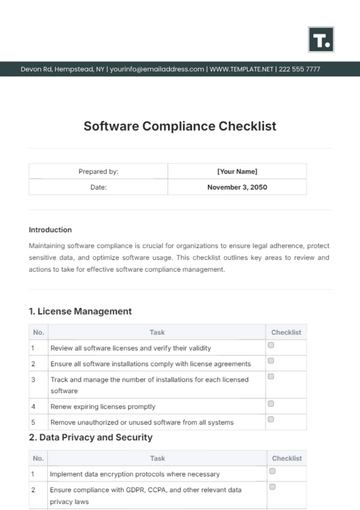Free Occupational Compliance Checklist

Prepared by: | [Your Name] |
Company Name: | [Your Company Name] |
Date: | September 20, 2050 |
Introduction
This Occupational Compliance Checklist serves as a comprehensive guide to ensure workplace safety, employee rights, health and wellness, environmental compliance, and regulatory reporting. By adhering to these protocols, organizations can create a safer and more compliant work environment, fostering both employee well-being and legal adherence.
A. Workplace Safety Protocols
Ensure all employees have completed mandatory safety training.
Verify the availability of first aid kits in accessible locations.
Conduct regular fire drills and maintain updated evacuation plans.
Inspect and replace personal protective equipment (PPE) as needed.
Ensure proper signage for workplace hazards and safety procedures.
B. Employee Rights and Responsibilities
Provide all employees with clear information on their rights and responsibilities.
Ensure equal opportunity policies are in place and communicated to all employees.
Record and resolve employee complaints promptly.
Ensure all employees have access to and understand the company’s code of conduct.
Regularly review and update employee handbooks and policies.
C. Health and Wellness Programs
Launch a workplace wellness program with physical and mental health initiatives.
Provide employees with access to mental health resources and support.
Offer regular health screenings and fitness activities.
Ensure ergonomic workstations to minimize physical strain and injury.
Provide healthy meal and snack options in the workplace.
D. Environmental Compliance
Ensure compliance with all relevant environmental regulations.
Conduct regular environmental audits to identify areas for improvement.
Implement a recycling program for waste reduction.
Reduce energy consumption by upgrading to energy-efficient systems and practices.
Ensure proper disposal of hazardous materials following regulatory requirements.
E. Regulatory Reporting and Documentation
Maintain accurate records of all compliance-related activities and inspections.
Ensure timely submission of regulatory reports to governing bodies.
Conduct internal audits to assess compliance with regulatory standards.
Review and update compliance policies and procedures regularly.
Train employees on the importance of regulatory compliance and accurate reporting.
- 100% Customizable, free editor
- Access 1 Million+ Templates, photo’s & graphics
- Download or share as a template
- Click and replace photos, graphics, text, backgrounds
- Resize, crop, AI write & more
- Access advanced editor
Ensure workplace safety and regulatory adherence with the Occupational Compliance Checklist Template from Template.net. Fully customizable to suit different industries, this editable checklist helps you manage safety protocols and regulations. Easily editable in our Ai Editor Tool, you can personalize it to fit your occupational compliance needs, ensuring a safe and compliant work environment for all employees.
You may also like
- Cleaning Checklist
- Daily Checklist
- Travel Checklist
- Self Care Checklist
- Risk Assessment Checklist
- Onboarding Checklist
- Quality Checklist
- Compliance Checklist
- Audit Checklist
- Registry Checklist
- HR Checklist
- Restaurant Checklist
- Checklist Layout
- Creative Checklist
- Sales Checklist
- Construction Checklist
- Task Checklist
- Professional Checklist
- Hotel Checklist
- Employee Checklist
- Moving Checklist
- Marketing Checklist
- Accounting Checklist
- Camping Checklist
- Packing Checklist
- Real Estate Checklist
- Cleaning Checklist Service
- New Employee Checklist
- Food Checklist
- Home Inspection Checklist
- Advertising Checklist
- Event Checklist
- SEO Checklist
- Assessment Checklist
- Inspection Checklist
- Baby Registry Checklist
- Induction Checklist
- Employee Training Checklist
- Medical Checklist
- Safety Checklist
- Site Checklist
- Job Checklist
- Service Checklist
- Nanny Checklist
- Building Checklist
- Work Checklist
- Office Checklist
- Training Checklist
- Website Checklist
- IT and Software Checklist
- Performance Checklist
- Project Checklist
- Startup Checklist
- Education Checklist
- Home Checklist
- School Checklist
- Maintenance Checklist
- Planning Checklist
- Manager Checklist
- Wedding Checklist
- Vehicle Checklist
- Travel Agency Checklist
- Vehicle Inspection Checklist
- Interior Design Checklist
- Backpacking Checklist
- Business Checklist
- Legal Checklist
- Nursing Home Checklist
- Weekly Checklist
- Recruitment Checklist
- Salon Checklist
- Baby Checklist
- Equipment Checklist
- Trade Show Checklist
- Party Checklist
- Hospital Bag Checklist
- Evaluation Checklist
- Agency Checklist
- First Apartment Checklist
- Hiring Checklist
- Opening Checklist
- Small Business Checklist
- Rental Checklist
- College Dorm Checklist
- New Puppy Checklist
- University Checklist
- Building Maintenance Checklist
- Work From Home Checklist
- Student Checklist
- Application Checklist



